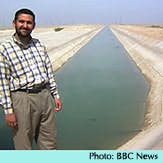A World Bank assessment in October 2003 concluded that only 6 out of 10 Iraqis in urban areas had safe drinking water, and, with leaks taken into account, Baghdad's water system was only meeting a third of the city's need.
Currently, about half of Iraq's wastewater flows untreated into the country's streams and rivers. Baghdad's three wastewater plants currently are inoperable, so the raw sewage from 3.8 million people flows daily into the river Tigris.
Water treatment facilities currently are operating at about 65% of their capacity due to years of neglect, power cuts and post-war looting.
Because of massive underinvestment in the 1990s, Iraq's water and sanitation systems were ailing even before the war began in 2003.
Since then bomb damage, looting and shortages of electricity, spare parts and chemicals have further worsened conditions.
Many areas have been dependent on water brought in by tankers, with USAid distributing 1.4 million liters each day to people in cities such as Basra, Kirkuk and Mosul.
Emergency repairs to systems in many parts of the country have been carried out, including fixing hundreds of broken pipes across the country.
Unicef says its programs have improved water quality for 1.6 million people and reduced sewage pollution for about 9 million people.
USAid is renovating eight sewage plants, including three in Baghdad, and five water treatment plants.
In addition, the agency is renovating a canal system in the south which provides drinking water to the 1.75 million residents of the city of Basra, and was, at its lowest point, operating at less than half its capacity.
Source: BBC News


